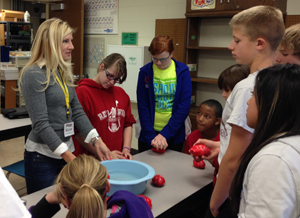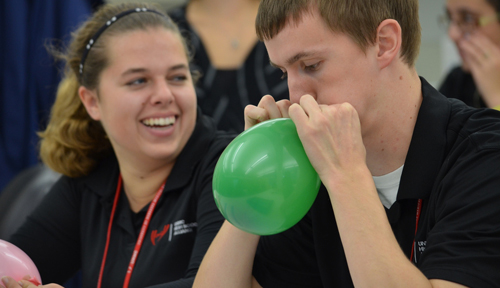It was a PhUn week.
Last week, The American Physiology Society held its annual, nationwide Physiology Understanding (PhUn) Week.
The purpose of the week is to bring hands-on activities to students at local schools to introduce them to physiology concepts and increase teacher recognition of physiology in their standards-based science curriculum.
For a slideshow of High School Alliance “PhUn” photos, click here.
 |
Cassie Hays, a master’s student in the department of cellular and integrative physiology, coordinates a muscle fatigue activity for students at Andersen Middle School. |
Graduate and post-doctoral students, faculty and staff from UNMC’s Department of Cellular and Integrative Physiology visited schools in Omaha, Council Bluffs and Lincoln, as well as meeting with UNMC’s High School Alliance students.
Karla Haack, Ph.D., of the department of cellular and integrative physiology, said the nationwide event allows faculty and students from her department to share their excitement about physiology with elementary, middle and high-school students in the community.
The department is going to more schools this year, including schools in the Lincoln community, and should see more than 500 students by the end of the fall, 200 more students than last year. The PhUn Week events have also led to longstanding relationships with some schools, such as Brownell-Talbot, for regular outreach events.
“PhUn week is special because it benefits everyone involved,” Dr. Haack said. “The students learn how different organ systems work together and actually get to see physiology in action. The teachers like that these activities reinforce and enhance concepts they are already teaching. And volunteers get a renewed sense of excitement for our field by getting to explain how interesting and fun physiology really is to young audiences.
“This activity will hopefully spark enthusiasm in young students to pursue careers in science and medicine,” she added.
Activities for UNMC’s PhUn Week this year included:
- Students measuring cardiovascular responses to everyday movements such as running, standing and laying down.
- Students immersing their faces in ice water to learn about the mammalian diving reflex and how a person’s heart rate changes.
- Students measuring muscle fatigue in response to continuous or intermittent hand grip using a dynamometer and EMG sensors.
- Students using balloons to calculate their own lung volume.
The department is expecting to reach more than 3,000 students through PhUn Week activities at the schools as well as a booth at this year’s Nebraska Science Festival.
